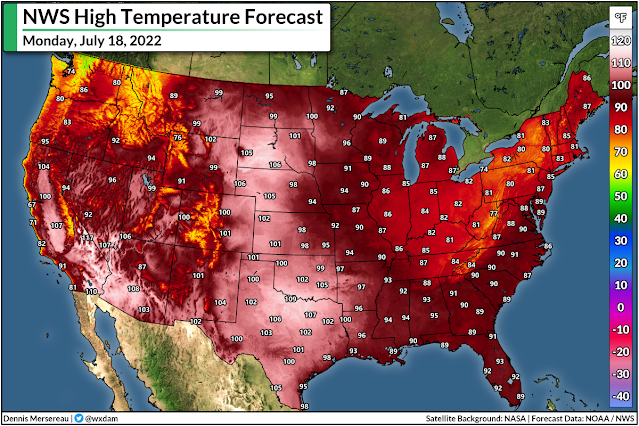An excessively hot summer across the U.S. rolls on this week as another stretch of dangerously hot temperatures spreads from I-5 to I-95.
Temperatures could easily crest the century mark for many locations over the next couple of days as broad ridges of high pressure rule the roost to start the week.
Tuesday will feature the worst temperatures, with 100-degree readings expected in Oklahoma City, Nashville, Washington, and Philadelphia. The high heat will stretch all the way into New England, where daytime highs in the 90s will reach into Maine.
Humidity will make the heat exceptionally dangerous in many of these locations, with heat indices exceeding 105 for many communities.
The National Weather Service's new HeatRisk product shows widespread "major" to "extreme" impacts from this latest bout of high heat.
Folks living with chronic health conditions, working outside, or living without air conditioning will feel the greatest impacts from this latest heat wave. Heat exhaustion or heat stroke can develop in under an hour with these conditions.
Very warm and humid nights won't provide much relief from the blazing daytime temperatures. The compounding effects of hot days and steamy nights will make this especially tough for folks without adequate cooling at home. Fans alone won't be enough to combat this heat.
This is the latest volley of blistering temperatures during an already-hot summer across almost all of the United States.
 |
| Source: IEM |
Data collected by the Iowa Environmental Mesonet shows that just about everyone save for the northern Plains and Upper Midwest has dealt with above-average temperatures so far this season. Much of the excessive heat has been driven by warmer-than-normal nighttime low temperatures, a side effect of the increased humidity we've seen this season.
 |
| Source: IEM |
Folks across the Southwest have taken the brunt of the extreme heat this year, with week after week of brutally hot temperatures roasting the region. Phoenix has seen above-average temperatures on 163 of the 195 days we've trudged through so far in 2024. The last time they saw a below-average day was at the beginning of May.
 |
| Source: IEM |
It's not just the Southwest dealing with the heat. It's a similar story back east. Washington, D.C., has seen above-average temperatures for 78 percent of the year through Saturday, July 13, and we're about to add another week of excessive heat to those grim statistics.
The relentless heat we've seen so far this year is exactly what you'd expect to see in a changing climate. Temperatures have steadily risen each decade across just about the entire United States—and we're even outpacing the new climate standards that run from 1991 to 2020.
 |
| Source: Climate Central |
Climate change sets a new baseline for extreme heat throughout the United States and around the world. As the entire frame of reference moves toward a hotter climate, warm temperature extremes are far more likely that cold temperature extremes. Excessive heat will come in hotter than what we grew used to just one or two generations ago.




















.gif)























